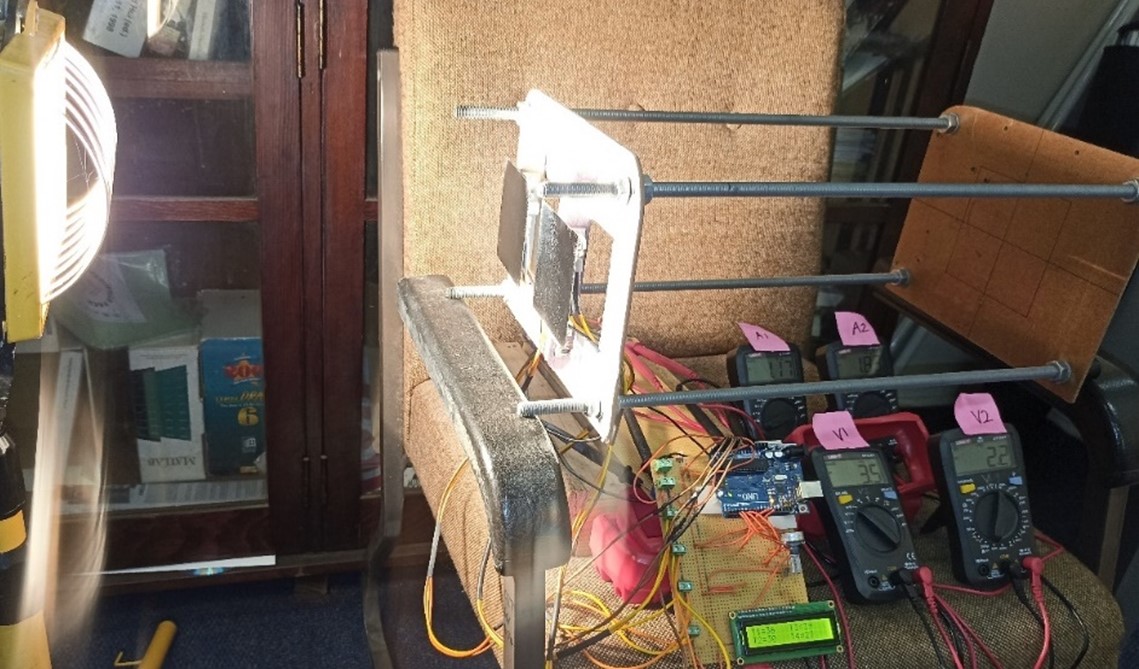Power output characterisation of thermoelectric generator units coupled to inverted box rib sheeting
DOI:
https://doi.org/10.17159/2413-3051/2023/v34i1a17264Keywords:
IV curve generation method, maximum power output, Peltier tiles, Pmax, temperature gradientAbstract
Abstract
There is a global need for clean and renewable energy sources. This study investigated thermoelectric generators (TEGs) as a possible method for harvesting solar power. The TEG prototype tested here consisted of two equally sized pieces of roof sheeting, with one side exposed to a light source and the other side shaded. Experiments were carried out with the necessary testing components to investigate the effects that two variables have on the amount of power generated: first, the colour of metal inverted box rib (IBR) sheeting and, second, the ideal electrical arrangement for scalability of Peltier tiles for maximum power output. Black-coated sheets generated maximum power (Pmax) output of the TEGs. The TEGs in series configuration generated the highest Pmax when located closest to the light source. The conclusion from the experiment is that TEGs are a potential method of harvesting solar energy on IBR sheeting, specifically in a vertical position. However, applications of different orientations and geographical locations require further investigation, including into the use of TEGs on IBR sheeting for harvesting solar energy on a larger scale.
Downloads
References
Aranguren, P., Araiz, M., Astrain, D. and Martínez, A., 2017. Thermoelectric generators for waste heat harvesting: A computational and experimental approach. Energy Conversion and Management, 148: 680-691. DOI: https://doi.org/10.1016/j.enconman.2017.06.040
Cao, Q., Luan, W. and Wang, T., 2018. Performance enhancement of heat pipes assisted thermoelectric generator for automobile exhaust heat recovery. Applied Thermal Engineering, 130: 1472-1479. DOI: https://doi.org/10.1016/j.applthermaleng.2017.09.134
Chen, W.H., Liao, C.Y., Hung, C.I. and Huang, W.L., 2012. Experimental study on thermoelectric modules for power generation at various operating conditions. Energy, 45(1): 874-881. DOI: https://doi.org/10.1016/j.energy.2012.06.076
Cheruvu, P., Kumar, V.P. and Barshilia, H.C., 2018. Experimental analysis and evaluation of a vacuum enclosed concentrated solar thermoelectric generator coupled with a spectrally selective absorber coating. International Journal of Sustainable Energy, 37(8): 782-798. DOI: https://doi.org/10.1080/14786451.2017.1365866
Dai, D., Zhou, Y. and Liu, J., 2011. Liquid metal based thermoelectric generation system for waste heat recovery. Renewable Energy, 36(12): 3530-3536. DOI: https://doi.org/10.1016/j.renene.2011.06.012
Fernández-Yáñez, P., Romero, V., Armas, O. and Cerretti, G., 2021. Thermal management of thermoelectric generators for waste energy recovery. Applied Thermal Engineering, 196, p.117291. DOI: https://doi.org/10.1016/j.applthermaleng.2021.117291
Hewawasam, L.S., Jayasena, A.S., Afnan, M.M.M., Ranasinghe, R.A.C.P. and Wijewardane, M.A., 2020. Waste heat recovery from thermo-electric generators (TEGs). Energy Reports, 6: 474-479. DOI: https://doi.org/10.1016/j.egyr.2019.11.105
Jaziri, N., Boughamoura, A., Müller, J., Mezghani, B., Tounsi, F. and Ismail, M., 2020. A comprehensive review of thermoelectric generators: Technologies and common applications. Energy Reports, 6: 264-287. DOI: https://doi.org/10.1016/j.egyr.2019.12.011
Jeyashree, Y., Sukhi, Y., Juliet, A.V., Jame, S.L. and Indirani, S., 2020. Concentrated solar thermal energy harvesting using Bi2Te3based thermoelectric generator. Materials Science in Semiconductor Processing, 107, p.104782. DOI: https://doi.org/10.1016/j.mssp.2019.104782
Kraemer, D., Jie, Q., McEnaney, K., Cao, F., Liu, W., Weinstein, L.A., Loomis, J., Ren, Z. and Chen, G., 2016. Concentrating solar thermoelectric generators with a peak efficiency of 7.4%. Nature Energy, 1(11): 1-8. DOI: https://doi.org/10.1038/nenergy.2016.153
Lashin, A., Al Turkestani, M. and Sabry, M., 2020. Performance of a thermoelectric generator partially illuminated with highly concentrated light. Energies, 13(14), p.3627 DOI: https://doi.org/10.3390/en13143627
Leonov, V., 2013. Thermoelectric energy harvesting of human body heat for wearable sensors. IEEE Sensors Journal, 13(6): 2284-2291. DOI: https://doi.org/10.1109/JSEN.2013.2252526
Leonov, V., Torfs, T., Vullers, R.J. and Van Hoof, C., 2010. Hybrid thermoelectric–photovoltaic generators in wireless electroencephalography diadem and electrocardiography shirt. Journal of Electronic Materials, 39: 1674-1680. DOI: https://doi.org/10.1007/s11664-010-1230-4
Lv, S., He, W., Hu, Z., Liu, M., Qin, M., Shen, S. and Gong, W., 2019. High-performance terrestrial solar thermoelectric generators without optical concentration for residential and commercial rooftops. Energy Conversion and Management, 196: 69-76. DOI: https://doi.org/10.1016/j.enconman.2019.05.089
McCarty, R. and Piper, R., 2015. Voltage–current curves to characterize thermoelectric generators. Journal of Electronic Materials, 44: 1896-1901. DOI: https://doi.org/10.1007/s11664-014-3585-4
Morais, F., Carvalhaes-Dias, P., Duarte, L., Spengler, A., de Paiva, K., Martins, T., Cabot, A. and Siqueira Dias, J., 2020. Optimization of the TEGs configuration (series/parallel) in energy harvesting systems with low-voltage thermoelectric generators connected to ultra-low voltage DC–DC converters. Energies, 13(9), p.2297. DOI: https://doi.org/10.3390/en13092297
Roof Source Pty Ltd. (2017) Roof Sheeting [Online]. Available: https://www.roofsource.co.za/roof-metal-sheeting/ [Accessed 26th September 2022].
Radian Thermal Products. Aluminium heatsink. https://www.radianheatsinks.com/aluminum-heatsink/ [Accessed 22nd September, 2022].
Sun, D., Shen, L., Yao, Y., Chen, H., Jin, S. and He, H., 2017. The real-time study of solar thermoelectric generator. Applied Thermal Engineering, 119: 347-359. DOI: https://doi.org/10.1016/j.applthermaleng.2017.03.075
Sundarraj, P., Maity, D., Roy, S.S. and Taylor, R.A., 2014. Recent advances in thermoelectric materials and solar thermoelectric generators–a critical review. RSC Advances, 4(87): 46860-46874. DOI: https://doi.org/10.1039/C4RA05322B

Downloads
Published
Issue
Section
License
Copyright (c) 2024 Momina Malik, Mark Gilpin, Bruce Graham

This work is licensed under a Creative Commons Attribution-ShareAlike 4.0 International License.



.png)